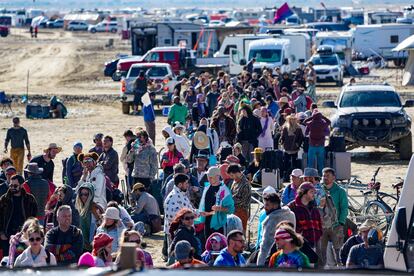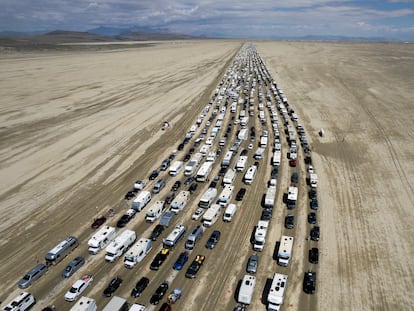Burning Man is ending, but the cleanup from heavy flooding is far from over
Torrential rains that closed roads, forced many to walk miles barefoot through the muck and slowed eventual exodus of vehicles might complicate the cleanup efforts

The rain has passed, and the temple has burned. Now, as Burning Man slowly empties, it’s time to clean up.
Burning Man organizers have three weeks to clean up the sprawling stretch of public land in the Black Rock Desert of northwestern Nevada, but a summer storm that left tens of thousands stranded in ankle-deep mud could alter that timeframe.
One of the principles of Burning Man is to leave no trace — an expectation that all attendees will pack out everything they brought to Black Rock City and clean out their camps before leaving.
But in the aftermath of torrential rains that closed roads, jamming traffic, and forcing many to walk miles barefoot through the muck, the area is dotted with abandoned vehicles, rugs, furniture, tents and trash. The ground itself has deep imprints and ruts.
Eleonora Segreti, who lives in central Italy and made her second visit this year to Burning Man, left the playa early Tuesday. She said everyone she knew was doing everything they could to clean up.
“It’s a very strong principle. Everybody, literally everybody that I know and that I talked to, they really take this ‘leave no trace’ idea seriously,” she said while waiting for a ride Tuesday at Reno-Tahoe International Airport after taking the shuttle there. “If it is a matter of staying overnight one extra day to do the work to clean up, most of the people are doing that.”
A permit issued by the U.S. Bureau of Land Management requires Burning Man organizers to clear the area of debris after vehicles exit the desert, about 100 miles (161 kilometers) northeast of Reno. Burning Man organizers did not immediately respond to questions from The Associated Press about how the rain will impact the cleanup timeline.
In October, teams made up of federal employees and Burning Man organizers will enter the festival site for an inspection.
Post-festival cleanup efforts include smoothing out the dried lake bed with large rakes attached to trucks and picking up trash on the highways leading to and from Burning Man, according to Bureau of Land Management spokesperson John Asselin.
Burning Man organizers will be on the hook for any needed repairs identified during the inspection, he said.
The annual celebration of free spirits in the remote desert emphasizes self-sufficiency. Many of the nearly 80,000 artists, musicians and activists who refer to themselves as burners arrive with limited supplies. Challenges in the form of brutal heat, dust storms and torrential rains are expected and, largely, welcomed.
While there, they build an elaborate city across 4 square miles (10 square kilometers) of colorful themed camps, decorated art cars and guerilla theatrics in preparation for the ceremonial burnings of a towering, faceless effigy and a temple dedicated to the dead. All of that is dismantled and to be hauled away when the festival ends.
Most attendees travel to the stark desert for a week to express themselves with music and art, and to commune with nature. Some visit the ancient lake bottom for a weeklong psychedelic party full of hallucinogens and nudity.
The wooden effigy burned Monday night, and the temple burned Tuesday night after being postponed because of heavy rain. More than a half-inch (1.3 centimeters) fell on Friday, turning the powdery desert floor into mud.
For many, torching the temple has become the centerpiece of the celebration — a more intimate, spiritual event than the rave party-like immolation of the figure. By tradition, revelers leave the names of departed loved ones and other remembrances to be burned in the temple.
Nevada state Rep. Mark Amodei, whose district includes Black Rock Desert, said Burning Man is overall positive for his community. But there is a lack of infrastructure at times to support the temporary city — not necessarily on the festival grounds itself, but in the two-lane road that takes people from Reno to the rural Nevada desert, cutting through the Pyramid Lake Paiute Tribe’s land.
Still, Amodei said, Burning Man organizers have been good partners with northern Nevada and have cleaned up after themselves in past years, as their event permit requires.
“So that’s going to be a little bit more of a chore this time,” Amodei told the AP. “And I’m sure they’re up to the task.”
Some festivalgoers plan to stay as long as it takes to clean the grounds.
“This is a national conservation area, and it’s part of our mission to leave it and as good a condition as we found it,” said Alexander Elmendorf, 36, who planned to stay there until Friday. “So that means getting every bed, utensil, every cigarette butt.”
Sign up for our weekly newsletter to get more English-language news coverage from EL PAÍS USA Edition
Tu suscripción se está usando en otro dispositivo
¿Quieres añadir otro usuario a tu suscripción?
Si continúas leyendo en este dispositivo, no se podrá leer en el otro.
FlechaTu suscripción se está usando en otro dispositivo y solo puedes acceder a EL PAÍS desde un dispositivo a la vez.
Si quieres compartir tu cuenta, cambia tu suscripción a la modalidad Premium, así podrás añadir otro usuario. Cada uno accederá con su propia cuenta de email, lo que os permitirá personalizar vuestra experiencia en EL PAÍS.
¿Tienes una suscripción de empresa? Accede aquí para contratar más cuentas.
En el caso de no saber quién está usando tu cuenta, te recomendamos cambiar tu contraseña aquí.
Si decides continuar compartiendo tu cuenta, este mensaje se mostrará en tu dispositivo y en el de la otra persona que está usando tu cuenta de forma indefinida, afectando a tu experiencia de lectura. Puedes consultar aquí los términos y condiciones de la suscripción digital.
More information
Archived In
Últimas noticias
Millennia-old Yuracaré language resists extinction through 900 speakers and a new dictionary
Susan Boyle prepares a comeback just as Timothée Chalamet sings her praises
Trump suspends green card visa lottery after shooting at Brown University
When things get out of hand at the lab: Hundreds of accidents expose the ‘catastrophic’ risk of dangerous pathogen leaks
Most viewed
- Christian Louboutin: ‘Young people don’t want to be like their parents. And if their parents wear sneakers, they’re going to look for something else’
- Cartels in Mexico take a leap forward with narco-drones: ‘It is criminal groups that are leading the innovation race’
- Liset Menéndez de la Prida, neuroscientist: ‘It’s not normal to constantly seek pleasure; it’s important to be bored, to be calm’
- ‘El Limones’ and the growing union disguise of Mexican organized crime
- The low-cost creative revolution: How technology is making art accessible to everyone









































